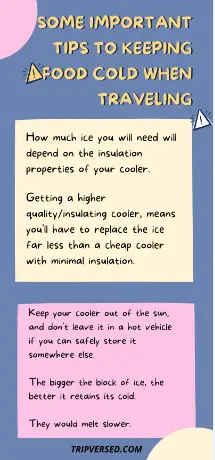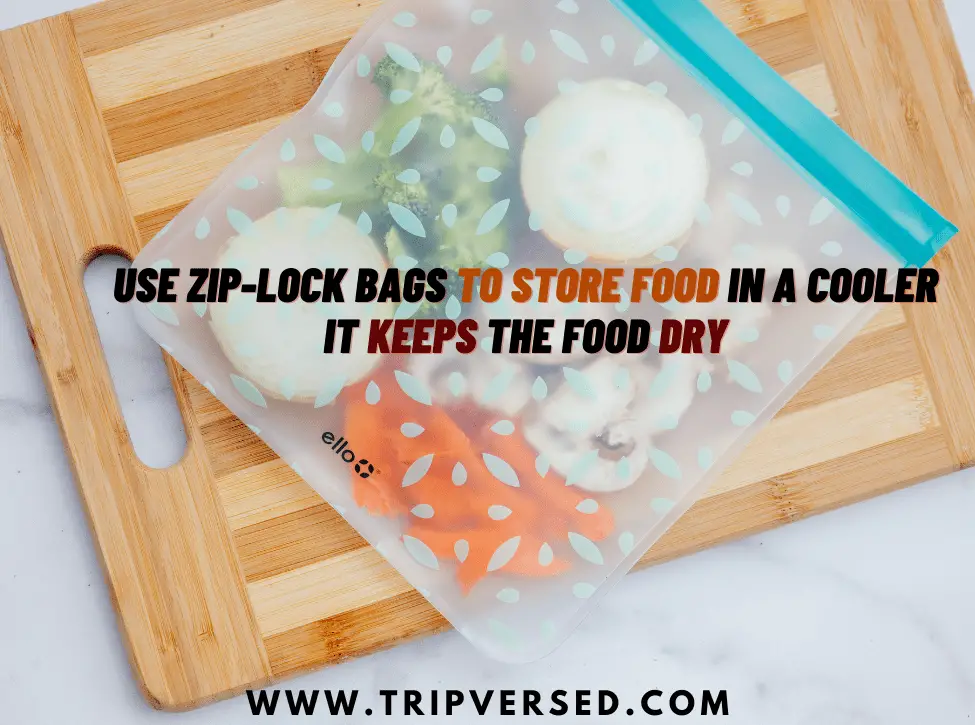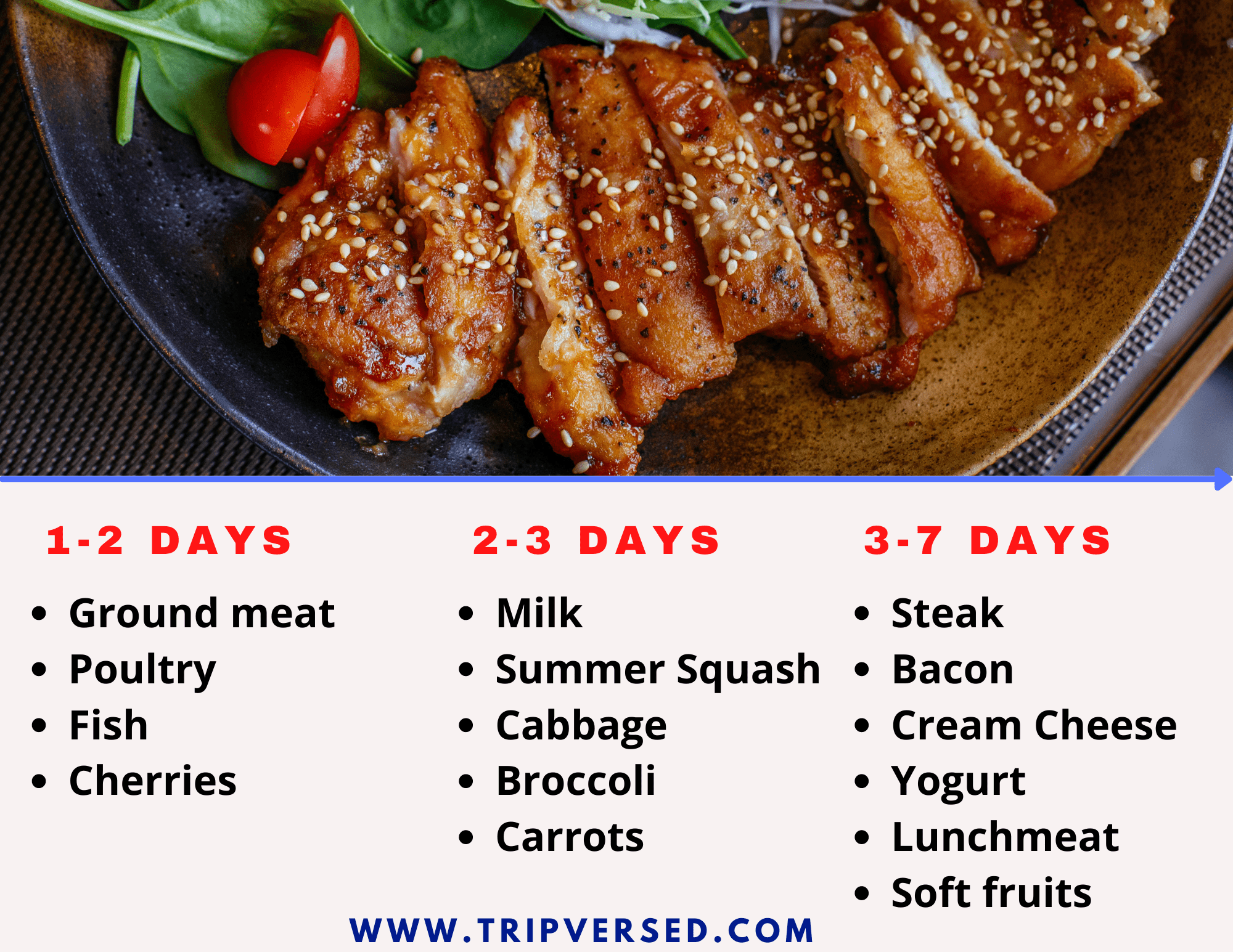Last Updated on November 24, 2023 by Rose Morah
Are you wondering how you can travel for long hours with perishable food but still keep it fresh?
In this article, we are going to discuss the best tips and hacks for traveling with perishable food for long hours.
Here is what we are going to cover:
- Tips for keeping food fresh and frozen when traveling by car.
- Tips to help you hold ice for long when traveling.
- How to keep food cold without a cooler.
| The best way to travel with perishable food is by keeping it as cold as possible throughout your journey |
- Tips for keeping food fresh and frozen when traveling for long hours
- 7. Put your cooler in the coolest part of your house, hours or the night before your trip.
- 8. If you are traveling by car, keep the cooler in an air-conditioned place and never in the car trunk.
- 9. Limit the number of times you open the cooler.
- How to keep food cold without a cooler
Tips for keeping food fresh and frozen when traveling for long hours
1. Buy fresh food

Research has shown that food bought directly from farmers’ market lasts twice as long as one bought from supermarkets.
Why?
- It is hard to know how long the product has been sitting on the shelves.
- Sometimes the food may be coming from other regions/states. This means it will already be a few days old by the time the product is available to buyers. And not to mention the stocking process. In other words, it will not be fresh, and may hence not last long.
See also: 5 Healthy Non-refrigerated Road Trip Snacks To Keep You Awake.
2. Carry the right cooler
Here’s what to look for in a cooler that you intend to use for storing your food when traveling for long hours:
- Choose a rigid cooler that is made of plastic or fiberglass
These types of coolers are more durable and keep your food cold even when exposed to the sun and wind.
- Choose a cooler that can keep out air
The cooler should be airtight.
Ensure that the seal around the lid lets in as little air as possible.
- Choose a cooler that best suits your traveling means
It is important to consider the weight and size of the cooler. For instance, hard-sided coolers tend to be heavier when compared to soft-sided coolers.
Hard-sided coolers will hence be great for travelers who plan to go on a road trip via car or RV.
On the other hand, travelers on an outdoor adventure such as hiking or on a paddling trip should consider getting a soft-sided cooler backpack.

The following are a few great examples of insulated cooler bags that help keep food cold and fresh for longer hours:

- Keeps food cold for 72 HOURS.
- With Earth Pack, there is no need to worry about leaks.
- It is waterproof.
- It is very spacious and comfortable to carry.

- It is waterproof.
- It is resistant to punctures and UV rays.
- It is portable and holds ice well.
3. Pack some ice
When flying to a destination, sometimes your checked luggage might stay on the tarmac under the hot sun for long hours, especially if you’re coming from hot places.
Locking up your cooler with a few frozen gel packs or some ice for about an hour or so will ensure that the frozen food doesn’t expend much of the cooler energy.
If you do not have frozen gel packs or ice, you can put ice cubes in a tightly sealed plastic bag (to prevent direct contact with the melting ice water), then add water and freeze it to make an ice block.
| Block ice keeps food items in a frozen state for much longer than ice cubes. |
Additionally, consider putting some of the ice at the bottom of the cooler, around the food as you pack, and most of it at the top to keep a consistent temperature.
Also, make sure the cooler is full. A full cooler stays cold longer than one that is partially full.
Related: How To pack and Travel With Frozen Food On A Plane.
Let’s tackle a few questions relating to ice and cooler
- Can you put ice in a cooler bag?
Yes, this will, in fact, help keep your food colder for longer.
But you will also need to ensure that the ice does not leak.
And speaking of leakage, I’d recommend you use reusable ice packs like the ones we’ve listed below. They don’t leak or mess things up in the cooler.
- How many ice packs do I need for a cooler?
It depends on three factors:
- How long do you want to keep your food cold
- The weather
- The size of your cooler.
A good rule of thumb, if you want to keep your food cold for longer, is to:
- Use more than two packs, depending on the size of your cooler.
- Ensure that you have a good-quality cooler. One that keeps the food cold for up to 72 hours.
- Do you put ice on the top or at the bottom of the cooler?
It depends. If the cooler will be exposed to the direct sun, put ice at the bottom to prevent it from melting fast.
If it is not going to be exposed to the direct sun for long hours, I’d recommend you put the ice at the top of the cooler.
- How long will ice last in a cooler bag?
2 to 5 days. After doing a test with more than ten different cooler brands, the ice in most cooler bags lasted for only three days.
This was contrary to what was stated in the product description (more than 5-10 days).
The best long-lasting (reusable) cold freezer packs for coolers

- They help keep food and drinks cold for up to 48 hrs.
- They are reusable.
- They can also be used to soothe injury, back pain etc.

- They help keep food cold for up to about 9 to 10 hours.
- They come with a set of 6 slime ice packs.
- They are reusable.
- Hard gel ice packs and lightweight.

- Great for sodas, beer cans, and breastmilk.
- Helps keep drinks cold for longer hours. Approximately 14 hours.
- They do not leak
Tips to help you hold ice for long when traveling
- Avoid buying loose ice at grocery stores and the gas stations
Since they melt so quickly, you may end up with a cooler full of water even before you reach your destination.
- Use large blocks of ice
Large ice blocks last longer, thus keeping food cold for longer.
- Dry ice lasts longer.
Dry ice lasts longer and, at the same time, keeps food dry.
However, it is important to properly handle dry ice due to the risk of cracking your cooler or burning your skin.
Therefore, make sure that you properly wrap the dry ice in a newspaper before placing it in the cooler to prevent your cooler from cracking.
Also, ensure that you don’t place it next to the food items that you wouldn’t want to be frozen.
4. Pack smart
A good rule of thumb is to immediately pack the food directly from the refrigerator into the cooler.
You should also avoid storing food in storage bags.
Why?
Because the humidity, dampness, or condensation inside the storage bag can make the food rot fast.
Instead, consider using sealed plastic containers or zip-lock bags. They help keep the food dry.

When packing, foods that defrost quickly, such as chicken, need to be put in a separate insulated container/cooler bag.
Veggies or greens need to be wrapped first in wet paper towels before putting them in storage bags. This helps keep them crisp for longer.
After packing all your food, make sure you leave at least an inch on top of the container to ensure that the lid doesn’t pop open after freezing. Food expands after freezing.
And another thing, the container needs to be tightly closed but not tapped.
| Quick tip: Securely wrap seafood, poultry, and raw meat and place them at the bottom of the cooler, separate from ready foods. Alternatively, you can pack the ready foods in a different cooler. This helps prevent any of their leakages from contaminating the rest of the food. |
5. Add an extra layer of insulation to the cooler
Adding an extra layer of insulation to your cooler helps create a shield against heat. To do this, you can use additional layers of plastic wrap, heavy-duty freezer bags, or a towel.
Using thick cooler towels, blankets, or reflectix helps insulate the cooler further and keeps it cold for longer.
6. Keep your perishable food at 40 °F or colder
Keeping your food at 40 °F or below will not only prevent it from spoiling but might also prevent you from getting sick.
Travelers need to know that bacteria that cause food poisoning start to snowball from temperatures between 40 °F and 140 °F.
I’d, therefore, recommend that you always carry a thermometer. Ensure that it reads 40 °F or below.
A thermometer will definitely help you know if your food is cold enough when traveling.

| The above image shows how long foods that have been packed in a cooler at temperatures of 40 °F or below will last. |
Other tips to help keep food cold when traveling by car
7. Put your cooler in the coolest part of your house, hours or the night before your trip.
8. If you are traveling by car, keep the cooler in an air-conditioned place and never in the car trunk.
9. Limit the number of times you open the cooler.
If need be, close the cooler as quickly as possible after opening it, and don’t leave it open for long.
How to keep food cold without a cooler
The following are simple, easy steps to pack food and ensure that it remains cold throughout the journey without a cooler.
1st Alternative
- Step 1.
Hours before your trip, store your food in containers and put them in the refrigerator.
- Step 2.
Ensure that they (containers) are sufficiently chilled before taking them out.
- Step 3.
Take another bigger container and put a few sheets of paper such as newspapers.
Lining the container’s inner side with the newspaper traps the cold and keeps out the heat.
- Step 4.
Place the refrigerated container inside the container in step 3. Add more sheets of newspaper on the top and seal the container.
- Step 5.
Take ice packs and wrap them in towels, then place them around the containers.
Alternative 2
If you’re going to be traveling by car for approximately 2 hours, be sure to follow these steps:
- Step 1.
Take a cast-iron pot and put it in the freezer for about one hour, or until it is ice cold.
- Step 2.
Pack your food in plastic bags.
- Step 3.
Put it in the ice-cold pot.
This method will only keep the food cold for only up to about 2 hours to the maximum.
Remember not to put the food in the car trunk or the warm sections of the car.




